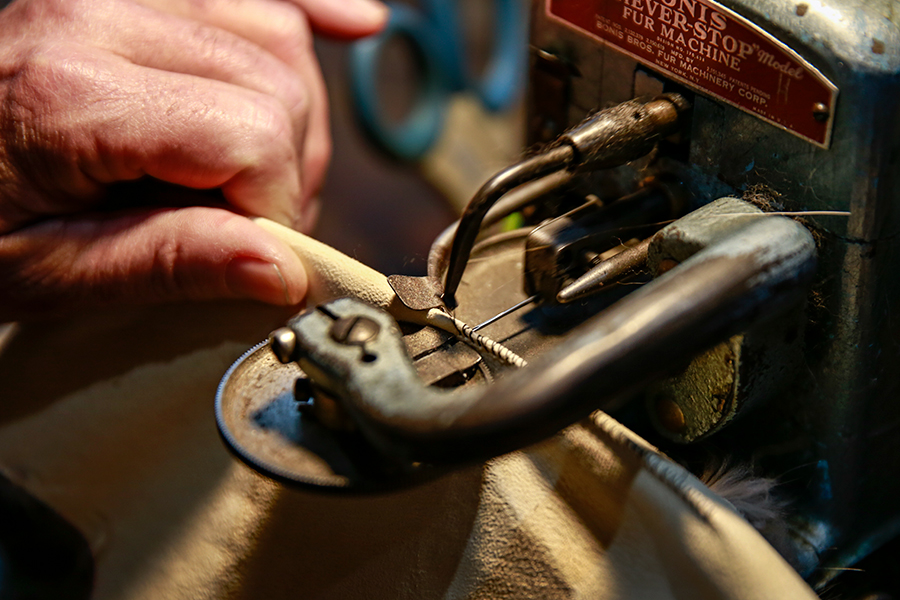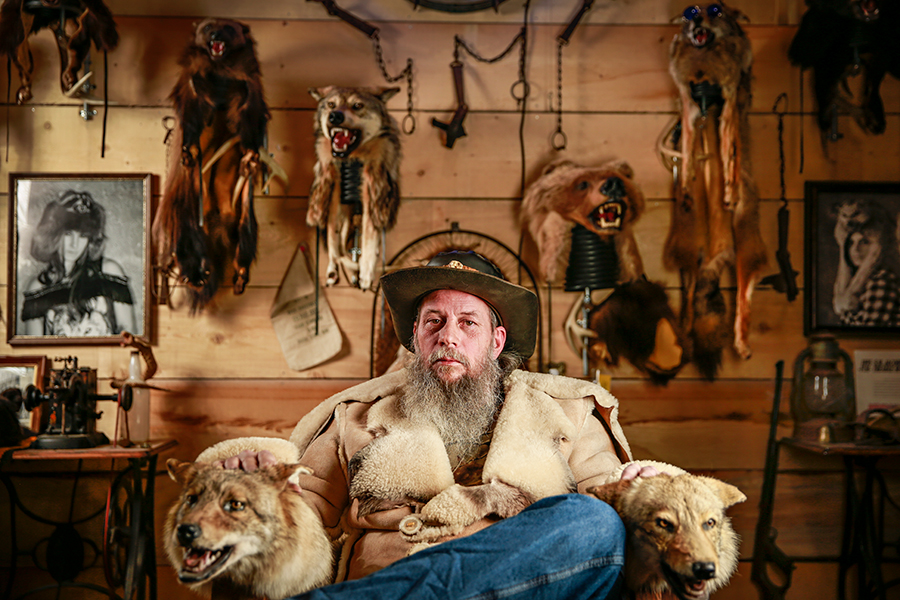In his 24-by-36-foot store in Kila, Brian Osterday can typically be found in the back room with one of his 18 antique sewing machines and an animal hide, often the thick pelt of a beaver or the softer, more colorful fur of a coyote.
The front room of his furrier shop, Wildlife Montana, looks like a museum. Wildlife head hats, still containing every part of the animal’s head besides the teeth, range from bobcats to bears. Osterday always keeps the first of each specific animal head he’s ever made to display in his store, which includes his only wolverine.
The adjacent walls are covered with fur slippers, muskrat baby booties, beer coozies and his most popular items that got him into the furrier business to begin with: fur mukluks, traditional boots made and worn by Alaskan Natives.
Osterday crafts each fur piece himself with one of his antique Bonis Brothers sewing machines, which weigh up to 64 pounds and date back to 1895.
“Each one of them has their own history,” he said.
The sewing machines that Osterday has acquired over the years were primarily used to sew together teddy bears and dolls in New York City back in the early 1900s. Osterday uses the machines, which have unique sideways needles, to stitch together virtually any type of fur garment, a skill that few people still possess in 2021.
“I feel like I was born about 100 years or so too late,” Osterday said. “But maybe I was meant to carry the torch. We’re all here for a purpose. We just don’t know what it is. We’ve all got great talent but some never find it.”

Originally from Duvall, Washington, Osterday and his wife moved to Minnesota in 1985 where he worked at Lund Boats for about 15 years.
Osterday grew up hunting and fishing and always knew he had a creative side, which he used in drawing, woodworking and welding, but he wasn’t introduced to the art of the furrier until the 1990s when he met Peter Paul.
“The story started before I was born,” Brian said. “It starts with Pete, the founding father of Peter Paul Furs.”
In the 1960s, Paul traveled from Minnesota to a remote area of Alaska to install power lines. One of his clients, an Alaskan Native woman, couldn’t pay him for his services, so she and Paul worked out a deal. In exchange for power lines, she taught him how to make traditional mukluks.
Paul brought his new skill back to Minnesota, where he opened Peter Paul Furs, which he ran out of his home with his wife. His shop ended up changing hands a few times throughout the years as Paul became preoccupied with other business endeavors. Osterday learned the trade from the shop’s most recent owner, and he eventually bought out Peter Paul Furs and opened his own store, Wildlife Minnesota, on Main Street in Perham in 2008 at the start of the Great Recession.
“Everyone looked at me and said, ‘You’re crazy,’” Osterday said. “I always said, ‘Well, if you can make it at a hard time, then easy times are going to be easy.’”
Despite the economic downturn, Osterday says the store did well. The mukluks were popular, but he also added to the inventory. While Paul made boots, hats, mittens and slippers, Brian started making head hats, which consist of the animal’s entire head except the teeth, after a customer requested one. Osterday continued modifying the process and makes them out of a variety of different animals.
“The head hats were my doing,” he said. “I brought the 20th century to it.”

Osterday says the head hats gained popularity quickly, especially for football games, and he’s made hats for Chicago Bears fans, Wisconsin Badgers fans and others. He’s also made them for celebrities like Fred Young of The Kentucky Headhunters, Babe Winkelman and models out of New York City.
Between the head hats, mukluks and his numerous other products like blankets, trooper hats and headbands, Brian has gained clients from all over the country and even Russia. With much of his business in the Midwest, he also sells his fur products to southern states like Georgia and Texas.
Rare animals like bobcats are typically his most requested head hats, but he makes most of them out of more commonly found animals like coyotes, beavers and raccoons. In his younger years, Brian trapped some of his own animals for the furs, but the 56-year-old became too overwhelmed in the winters and describes trapping as a “young man’s job.”
Now, he buys from other trappers and fur buyers, while many of his clients supply their own fur.
“This is a good alternative,” he said. “It’s another way to utilize fur. They’ll trap all year long and come to me and have stuff made for their family members. It’s a lot better than putting it on the market.”
Osterday says the durability of each animal’s fur is different, with beaver on the thicker side, but he says the hide is the most important part.
“This is why man cannot recreate fur,” he said. “The fur actually blocks the wind and repels the water, but the hide is the key ingredient. The hide lets it breathe; when it gets to a certain temperature the hide releases the heat. That’s why man cannot recreate that, because he cannot create hide.”

After more than a decade of running Wildlife Minnesota in Perham, Osterday and his wife moved to the Flathead Valley in 2019, where they already had family and planned to build a new fur store.
Wildlife Montana sits on his Kila property, just a stone’s throw away from his home with far less foot traffic than his old shop on Main Street in Perham.
Driving directions to the store are also slightly less intuitive than his old shop. Rather than plugging the address into Google maps, Osterday tells people to drive to Kila Hill Road and follow the “fur shop” arrows that he installed on telephone poles and signs leading up to his home.
Brian planned to head into semi-retirement in Kila while his 33-year-old son, Ashton, ran Wildlife Minnesota. But the COVID-19 pandemic had other plans, and when the Minnesota store reopened last spring, Ashton closed the storefront on Main Street and is now only taking fur orders from his garage, but he plans to continue the trade his father taught him.
Ashton started learning the furrier business about five years ago and took over Wildlife Minnesota last winter before the pandemic began. He remembers when his dad first started as a furrier.
“I thought it was really cool,” Ashton said. “It suited him … When he started doing it, I thought, ‘He’s really going to take off.’ It’s something he’s passionate about.”
As a kid, Ashton remembers his father’s paintings decorating the bathroom and says he was also responsible for the home’s outside décor.
“He’s got that sense of design,” Ashton said. “I’ve seen some of his art and stuff from high school, plus his passion for the outdoors. He really gets to express his creativity with fur.”

While Ashton loves the furrier craft, he says he doesn’t have the passion for it quite like his dad. But he sees the passion in his own son, Ezekiel. While he’s only 4 years old, both Ashton and Brian hope to teach the furrier trade to him when he’s older.
“He loves fishing and he loves hunting,” Ashton said. “He is way more into that than I was when I was a kid. I feel like he’s going to be like his grandpa.”
Osterday hasn’t taught anyone else the skill other than Ashton. But he says he’s tossed around the idea of having an apprentice if the opportunity arises. He also makes tutorial videos so that he’ll have the option to share them some day if he isn’t around to teach anybody, and he’s thought about making how-to kits.
Even though trades aren’t passed down through generations like they were historically, Osterday has faith that the furrier trade will survive.
“It’s a trade, that’s one of the sad things,” he said. “A lot of trades have died off over the years. You look at Pete, if he didn’t pass it on, it’d be gone. I’m the only one left in the Lower 48 states that makes fur mukluks.”
Osterday often feels like he was born in the wrong era with his passion for an old trade that was much more lucrative a century ago. But he believes he was meant to carry the furrier trade on to future generations.
“It’s not too often you run across a person like me,” Brian said. “I’ve come a long way that’s for sure. I know a lot of people look at me like I’m crazy.”
Wildlife Montana is located at 237 Forest Ridge Trail in Kila. For more information, visit www.wildlifeminnesota.com.
